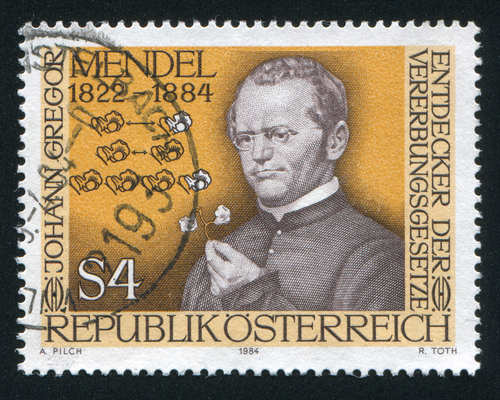Mendelian Inheritance: rules that explain the common patterns of single gene (inheritance). The outcome of a single trait is governed by a single gene. (Brooker, 350)
The term 'Mendelian' refers to Gregor Mendel, an Austrian who did pioneering work on "genes" and "traits" in ordinary garden peas by showing that a single trait, such as color, can be determined by a single gene. (GNN) Mendel reasoned that each parent must contribute one gene to each "offspring," resulting in a pair of genes for each trait. (Micklos, 14) Mendel provided a basis for the mathematical analysis of inheritance. He showed that traits are inherited in a predictable manner as (what he called) “factors,” which we now call “genes.” Mendel showed that genes governing individual traits do not blend. Instead, genes are maintained as discrete bits of “hereditary” information, unchanged through “generations.” (Micklos, 12) Also referred to as 'single-gene inheritance,' 'monogenetic inheritance,' 'qualitative inheritance,' and 'discrete inheritance.'
Dominant: an “allele” is said to be dominant if it is always expressed in the “phenotype” of an organism. In peas, the allele for green pods, ‘G,‘ is dominant to that for yellow pods, ‘g.‘ Since the allele for green pods is dominant, pea plants with either the “genotype” ‘Gg‘ or ‘GG‘ will have green pods. (Indge, 87) The presence of the dominant allele masks the presence of the "recessive" allele. (Brooker, 341) An organism is "homozygous" for a gene when it carries two identical alleles, one from each parent. If those identical alleles are of the dominant allele, then the organism is ‘homozygous dominant,’ and expresses the dominant trait. (Mikulecky, 230) Also referred to as ‘completely dominant.’
Autosomal Dominant: a trait that affects both sexes and appears every generation. (Lewis, 70) If a child has the trait, at least one parent also has it. (In this mode) traits do not skip generations. If no offspring inherit the trait in one generation, its transmission stops because the offspring can pass on only the recessive form of the gene. (Lewis, 75) Also referred to as 'autosomal dominant inheritance.'
Codominance: inheritance pattern that occurs when both alleles are phenotypically detectable in "heterozygotes." (Norman, 7/21/09) Two alleles are said to be codominant if both are expressed in the phenotype of the heterozygote. (Indge, 64) An example is found in the alleles that determine blood type. Heterozygous persons who possess both ‘A’ and ‘B’ alleles express ‘A’ and ‘B’ blood types equally, and are therefore blood type ‘AB.’ (Mikulecky, 233)
Codominant Alleles: both expressed in the phenotype. (Lewis, 106)
Incomplete Dominance: inheritance pattern that occurs when the heterozygote has a phenotype intermediate to the phenotypes of the dominant and recessive homozygote. (Brooker, 341) For example, red flower parent, white flower parent, pink flower offspring. (Norman, 7/21/09) Sometimes the relationship between dominant and recessive alleles isn’t an all-or-nothing situation. One allele may be only ‘partially dominant’ over the other, allowing the 'partially recessive' allele to be expressed to some extent in a heterozygote. (Mikulecky, 233)
Incompletely Dominant Alleles: heterozygotes of these have phenotypes intermediate between those associated with two homozygotes. (Lewis, 106)
Law of Independent Assortment: the idea that the alleles of different genes assort independently of each other during sperm cell formation and egg cell formation. (Brooker, 332)
Law of Segregation: the idea that the two copies of a gene segregate from each other during transmission from parent to offspring. (Brooker, 328)
Recessive: a trait that is masked by the presence of a dominant trait in a heterozygote. (Brooker, G-31) The only way one can express a recessive trait is to receive a recessive gene from each parent. (Norman, 83) An allele is said to be recessive, if it is only expressed in the phenotype (when) the other allele of the pair is identical. In peas, the allele for yellow pods ‘g’ is recessive to that for green pods, ‘G.’ Since the ‘g’ allele is recessive, only pea plants with the genotype ‘gg’ will have yellow pods. (Indge, 228) An organism is ‘homozygous recessive’ if it carries two alleles for the recessive form of a trait and expresses the recessive trait. (Mikulecky, 230)
Autosomal Recessive: genetic conditions that occur only when mutations are present in both copies of a given gene. (NCIt) One of several ways that a trait, disorder, or disease can be passed down through families. An autosomal recessive disorder means two copies of an abnormal gene must be present in order for the disease or trait to develop. (PubMedHealth2) Can appear in either sex. Affected individuals are ‘homozygous recessive’ for that trait. (Lewis, 75) Also referred to as 'autosomal recessive inheritance.'
